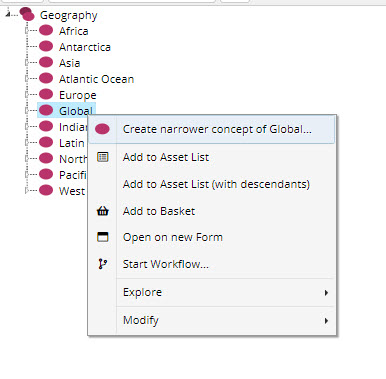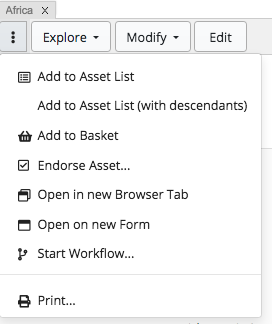Working with Taxonomies
The Taxonomies collection type supports creating asset collections based on SKOS (the Simple Knowledge Organization System), the W3C standard ontology designed for representing taxonomies, thesauruses, and subject heading schemes.
EDG taxonomies are SKOS-based collections (i.e. datasets). When a new taxonomy collection is created, EDG will automatically include the SKOS ontology. SKOS provides a definition of Concept and related classes and their properties e.g., fields like preferred and alternative labels, various notes and relationships. Other EDG collections do not typically or automatically include SKOS, although they may.
Every taxonomy is expected to have at least one Concept Scheme that identifies its “top concepts”. A taxonomy can have multiple concept schemes; however, a better practice can be to use a single concept scheme per individual taxonomy. Since taxonomies can, as can all asset collections, be included into each other, a taxonomy with multiple concept schemes can be assembled through inclusion of several single concept scheme taxonomies.
Use of the pre-defined SKOS fields can be configured locally for a given taxonomy, globally for the entire EDG or for a subset of taxonomies e.g., all taxonomies associated with some business area. You can disable fields for all or a group of taxonomies by taking advantage of the Ontology modeling functionality in EDG - see Working with Ontologies.
Rules and constraints specified by SKOS are also included by default, as are other common constraints for taxonomies e.g., a concept must have a broader parent or be a top concept of some scheme. If desired, they can be disabled.
Ontologies are also used to define custom, non-SKOS properties for taxonomy concepts and to define specializations (sub classes of concepts). If you customize SKOS, make sure that the ontology with your customizations is included in the taxonomies to which the customizations apply. There is a system-wide setting your EDG administrator can use to ensure that the customized ontology is included in every new taxonomy. If customization only applies to a subset of taxonomies, creator of a taxonomy collection can use the Settings, Includes dialog to include the customized ontology.
See also
Please see the Working with Asset Collections for all the general features of asset collections such as import/export, editing, user permissions, reports and settings.
Taxonomy Editor
For taxonomies, the default editor layout is the Taxonomy Concepts Panel tree view and the details Form Panel. Just like the other collection editors, the UI for this editor can be customized and arranged and comes with many panels and layouts.
See also
For more information on using EDG editors please see Using Forms to View and Edit Asset Information.
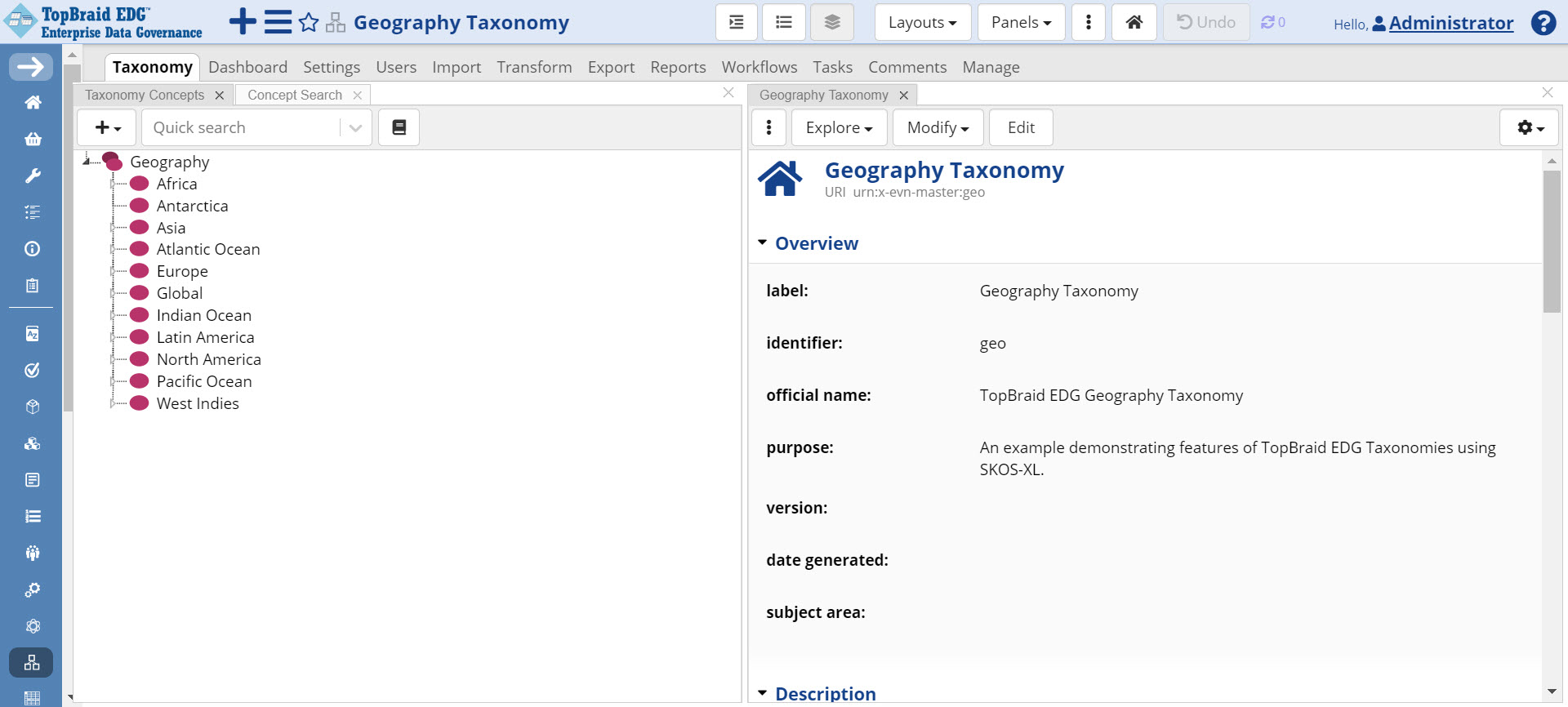
TopBraid EDG Geography Taxonomy Page
Taxonomy Concepts Panel
This panel displays taxonomy concepts organized into concept schemes. It also lets you create new concepts and schemes.
A concept scheme provides an additional organizing context for a collection of concepts in a taxonomy. A concept is said to belong to a concept scheme if it is a child (directly or indirectly) of a top concept. Once a scheme is created, top concepts are added to it. A concept must belong to at least one concept scheme in order to be displayed in the Taxonomy panel, but it can also belong to more than one, if needs be.
You can create concept schemes and concepts using icons positioned in the header of the panel.
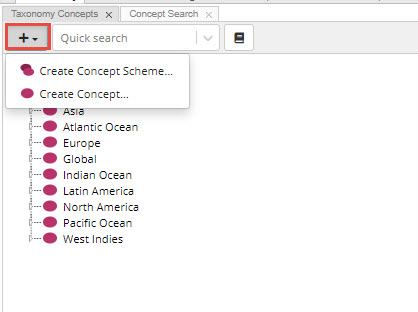
TopBraid EDG Creating Concept Schemes and Concepts
Taxonomy Concept panel has a quick search field. It lets you quickly look up concepts of interest. Lookup will only search for concepts presented in this panel i.e., those that are connected to concept schemes. The icon to the right of the Quick search field will switch from autocomplete lookup based on the preferred label to the full text search across all string properties.

TopBraid EDG Switch to Full Text Search Option
Note
When Quick search is in full text mode, the look up will be routed through the Lucene index and will be subject to its behavior …. for more information about the Lucene index see EDG Configuration Parameters.
If you right click on a concept scheme in this panel, EDG will display the right click menu with the following options.

TopBraid EDG Concept Scheme Right Click Options
Create Top Concept
Lets you create a top concept for a scheme.
Add to Asset List
Adds selected class to a sharable asset list. Asset lists are available in the Creating and Using Asset Lists and used for bookmarking or bulk actions.
Add to Basket
Basket (see Bookmarking Asset Collections and Assets) is similar to Asset List but for all of EDG. It is located in the main header bar. Here you create create new versions of collection or bookmark assets or collections. This is per user and not shared.
Open on new Form
This opens the Editing Assets using Form Panel for the selected class.
Start Workflow
Starts a Workflows for this selected class in this collection.
Create Narrower Concept of …
Lets you create a “child” concept of the selected concept.
Add to Asset List
Adds selected class to a sharable asset list. Asset lists are available in the Creating and Using Asset Lists and used for bookmarking or bulk actions.
Add to Basket
Basket (see Bookmarking Asset Collections and Assets) is similar to Asset List but for all of EDG. It is located in the main header bar available on every page. Here you create create new versions of collection or bookmark assets or collections. This is per user and not shared.
Open on new Form
This opens the Editing Assets using Form Panel for the selected class.
Start Workflow
Starts a Workflows for this selected class in this collection.
Explore Menu

TopBraid EDG Explore Menu
Provides access to the following operations:
Find Similar Assets … – will open a search dialog to select similarity criteria
Show Affected Workflows … – will check if any active workflows contain any changes to the selected concept
Show Comments … – will let you view already created comments for the selected concept and will let you create new comments
Show Tasks … – will let you view already created tasks for the selected concept and will let you create new tasks
Show NeighborGram – will display NeighborGram panel for the selected concepte
Show Relationship Tree – will display Relationship Tree panel for the selected concept
Export Hierarchy to Spreadsheet – will export the tree branch starting with the selected concept into a spreadsheet format using columns to represent levels of hierarchy. This will open in your browser, save to a file and then open in a spreadsheet to convert.
For example:
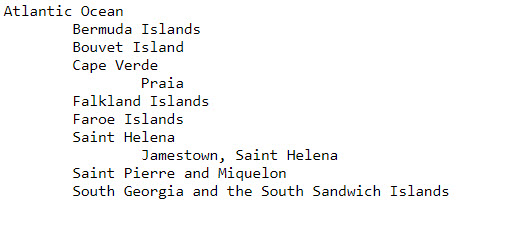
TopBraid EDG Explore Menu Example
Modify Menu

TopBraid EDG Modify Menu
Provides access to the following operations:
Create multiple concepts …- will let you enter names of multiple concepts, creating them in one step.
Clone … – will clone the selected concept. All children of the selected concept will be children of the clone.
Clone with descendants … – will clone the entire tree branch. See
:ref:`cloning_and_replacing_targetAssets for more.Replace … – will replace selected concept. See Cloning and Replacing Assets for more.
Refresh details of remote values … – this option will appear if a concept is mapped to a resource from a remote Knowledge Graph and some of its value are derived from data in a remote graph. It will refresh derived values.
Suggest matching WIkidata resources … – this option will appear if a concept type is mapped to a remote SPARQL endpoint. It will return resources from a remote Knowledge Graph that are likely matches to the selected concept.
Delete – after confirmation, will delete the selected concept. Children will not be impacted.
Delete with descendants – after confirmation, will delete the entire tree branch. Children will be deleted with the exception of children that have multiple parents and one of the parents is outside of the branch.
This panel has no Settings menu.
Merging
When you merge two concepts or concept schemes, you’re deleting one and moving its property values to another. For example, let’s say you have a concept with a preferred label of “Caribbean” selected on the concept hierarchy, and it has a scope note value of “Does not include Greater Antilles”. To merge it into the “West Indies” concept, transferring the property values to it, select Caribbean on the Concept Hierarchy and then select Merge into concept…” from the gear menu at the top of the form. Enter “West Indies” in the dialog box that displays and press Enter.
When you are finished, the Caribbean concept will no longer be there, and the West Indies one will have a scope note value of “Does not include Greater Antilles” (if it didn’t already) as well as any other values formerly assigned to Caribbean. Also if Caribbean was used by some other vocabulary (including transitive imports and usages in Tagger graphs) then those references there are also updated. One exception is the Caribbean concept’s preferred label value of “Caribbean”, which instead of becoming an additional preferred label for “West Indies”, will become a new alternative label for it, because a concept should not have two preferred labels in the same language.
From version 5.2, merge also has a transitive side-effect such that if Concept A is merged into Concept B and A was used by some other vocabulary (including transitive imports and usages in Tagger graphs) then those references there are also updated.
Note
This does not happen for workflows because by default they are not committed, so the changes cannot be propagated.
The changes to other graphs will not show up in the change history.
Replacing the ID (URI) of an asset will move all information about it that exists in the current asset collection to the new ID. This includes any references to the asset. If no other collection refers to this asset then this operation will effectively delete the “old” ID. However, any information about this asset contained in other collections will continue to refer to the “old” ID. You should proceed with this operation only if all information about the asset is contained within this collection, or you understand the implications of this change and, if needed, are prepared to adjust other asset collections.
Cloning and Replacing
The Clone and Replace operations are available under the Modify menu.
Clone creates a copy of the selected asset. The label of the clone (preferred label in case of SKOS Concepts) will be set as the label of original asset with “ Copy” appended to it.
Replace, creates a clone of the selected asset using URI that you will provide and then deletes selected asset. One difference with the clone operation above is that the label will be the same as the label of the original asset, “ Copy” will not be appended. You can use this operation to modify the URI identity of a resource.
Warning
EDG will automatically adjust all incoming and outgoing references, however, it will do so only for the current asset collection. Other asset collections will not be updated, meaning any references to the replaced asset that they contain become broken links. Using the Expore menu Find Usages in Other Asset Collections… feature is recommended before doing a Replace.
See also
To understand possible impacts of delete operations see Deleting Assets .
Deleting Assets
You can delete assets directly in an asset collection or you can start a workflow and delete in the workflow of the collection. See Starting a Workflow for the information on how to start a workflow.
With asset information displayed on a form, click on Modify button and select Delete.
You can also select Modify>Delete by using a right click in the Classes, Node Shapes and Taxonomy Concepts panels.
For Taxonomy Concepts only, in addition to Delete, there is an option to Delete with descendants. This deletes an entire tree starting with the selected concept.
Since asset collections in EDG can include each other by reference, some care needs to be taken when deleting assets. Delete operation only deletes references to the deleted asset that exist in your current asset collection. Consider the following scenario:
Taxonomy 1 defines Concept A
Taxonomy 1 also defines Concept B making it a child of Concept A
Taxonomy 2 includes Taxonomy 1
Taxonomy 2 defines Concept C making it a child of Concept A
You go to Taxonomy 1 and delete Concept A. Concept B’s reference to A will be removed, but Concept C’s reference to A will stay. Now concept C has a broader relationship to an undefined concept
Running Problems and Suggestions report on Taxonomy 2 will report the issue and assist you in removing such references.
Similarly, deleting a class (asset type) from an ontology will not remove class instances (assets of a given type) that may be stored in another asset collection. It will make them members of undefined class. Deleting a property does not delete property values that are held in another asset collection.
Running Problems and Suggestion report will help you identify and fix these issues. Further, by going to the Settings>Included By you will see all asset collections that include your selected collection. You can then go to them and use References panel to identify what may be referring to a resource you are planning to delete.
Taxonomy Specific Import Considerations
EDG Taxonomies features include the following special importers:
Importer Details
When using Import RDF File to import data into a collection, EDG performs some transformations. This is done to ensure that imported concepts are visible in the Taxonomy Concepts panel. These modifications are as follows:
“Narrower concept” relationships will be used to generate inverse “broader concept” relationships
A Concept scheme will be added if none exists. Concepts without broader parents are made top concepts of the scheme
Note
See the SPIN rules in TopBraid/SKOS/skoscleaner.ttl in the EDG workspace for technical details.
When using Import Spreadsheet using Pattern, hierarchical spreadsheet imports will also create concept schemes.
Taxonomy Specific Exports
EDG Taxonomies features include the following special exporters:
Taxonomy Specific Edit Operations
In addition to create operations described in the Create New Assets and Clone and Replace sections, new taxonomy concepts can be created as follows:
Select a parent concept, then select Modify>Create multiple concepts… Create multiple instance dialog lets you enter labels for new concepts – one label per line. All labels must be in the same language.
Select a parent concept, then select Modify>Clone with descendants … This will clone an entire tree starting with the selected parent concept.
Also see Taxonomy Concepts Panel for additional information.
When you create a child concept, you may want its type to be based on the type of a parent concept. For example, you may want to make sure that all children of assets of type Continent are Countries. To get this behavior, you need to specify a constraint on the ‘narrower’ relationship in the ontology your taxonomy is based on. The constraint must be created on the inverse of skos:broader. For example:
Go to the Geo Ontology and select Continent. Then, create a property shape for inverse of skos:broader. Do not modify the existing shape for inverse of skos:broader declared at Concept. You want to create a new one, specifically for the Continent
In the create dialog, enter Country in the class field
Now, when creating a child of a continent, you will no longer be asked to select a type, it will be automatically created as a Country.
Taxonomy Specific Reports
In addition to the general reports, there the following specialized Reports tab capabilities for taxonomies:
Taxonomy Statistics Report which Displays bar charts for the number of nodes per level and the distribution of the number of children.
SKOS-XL Taxonomies
SKOS-XL (SKOS eXtension for Labels) is a part of the W3C SKOS standard that lets you treat labels as resources in their own right, with their own metadata. This may be useful for adding provenance data or information for text mining tools about how to use specific labels. TopBraid EDG lets you use SKOS-XL to add any metadata you like to alternative and hidden labels. Starting with release 6.3, EDG also lets you add metadata directly to links between a concept and its textual labels as detailed in Enabling Reification of Property Values . This may serve as an alternative to SKOS-XL – an alternative that supports capture of label metadata without the added complexity of managing labels as independent resources.
To activate the SKOS-XL support for a particular taxonomy, select Settings > Includes and check SKOS XL SHACL Shapes to include SKOS-XL. Then, when you edit concepts in that taxonomy, the edit forms will let you add existing label resources as the values of alternative and hidden labels. Once a label’s data has been entered, it will appear like any other relationship property value on the relevant form: as a hypertext link. You will be able create new labels using “Create New” as part of the editing concept information. Or, alternatively, you can create and work with label resources independently from concepts. To do so, switch to the Search panel (or Search layout) and select Label from the asset type navigator.
Note
SKOS-XL SHACL Shapes only provide skosXL:altLabel and skosXL:hiddenLabel relationships so that you can create separate label resources for them.
A concept still needs to have a textual label. This means that even with SKOS-XL, TopBraid EDG will continue to use skos:prefLabel as a direct label of a concept.
EDG uses resource’s textual label (either skos:prefLabel or rdfs:label) as a display name consistently across all the UI. Further, TopBraid EDG creates text indexes of concepts (and other resources) to facilitate auto-complete and search. The indexing process uses resource’s label.
SKOS-XL defines only one property for the Label class – literal form. As previously mentioned, EDG uses either skos:prefLabel or rdfs:label as resource names. There is a special “hard coded exception” from this rule for the SKOS-XL Label resources. Even-though the create dialog for them says “label”, the value entered as a label is stored in the skosXL:literalForm property. EDG will understand that for Label resources this property is used as their name. To associate a new property with a SKOS-XL label use the same Ontology customization capabilities as you would use to create new properties for concepts.
Transform SKOS-XL
On the Transform tab of Taxonomies you will find an option to convert SKOS-XL labels to reified values.
This feature will convert any instances of skosxl:Label to values of their corresponding direct SKOS properties:
skosxl:prefLabelis converted toskos:prefLabelskosxl:altLabelis converted toskos:altLabelskosxl:hiddenLabelis converted toskos:hiddenLabel
If the skosxl:Label has other properties than skosxl:literalForm and rdf:type then these values will be converted into reified statements.
For example, if your skosxl:Label instances have values for ex:isAbbreviation and skosxl:prefLabel was used to point to the label, then there will be a reified triple attached to the skos:prefLabel statement to store these additional values.
The ontology should define suitable node shapes that define the properties such as ex:isAbbreviation for display and editing purposes, and attach them to the property shapes of properties such as skos:prefLabel using dash:reifiableBy
Optionally, the original URIs of the skosxl:Label instances will be stored as reified triples and the property dash:uri which can then be used to restore the original skosxl:Label instances as part of an exporter.
